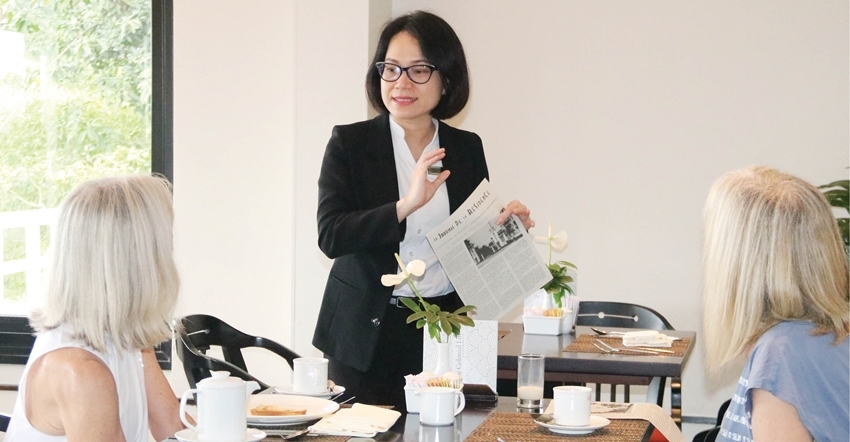 |
| Azerai La Residence Hue Hotel being introduced to visitors |
All roads... lead to Hue
In mid-February 2025, passengers at Phu Bai International Airport couldn’t help but be amazed when they witnessed the landing of a Gulfstream G650ER private jet, registered VN-A968, carrying a number of passengers to Hue. The jet, designed for the ultra-wealthy, features interiors such as a bed, kitchen, bar, relaxation sofa, television, and a 5-6-star standard living room. Many billionaires and ultra-rich individuals around the world own Gulfstream jets, including Bill Gates, Jeff Bezos, Cristiano Ronaldo, and Lionel Messi. Therefore, the appearance of the Gulfstream G650ER in the ancient capital is both a pleasant surprise and a promising sign for Hue’s tourism industry.
It is considered a positive sign because Hue now appears to welcome wealthy tourists through nearly all forms of transportation in addition to air travel. At the end of 2024, the five-star Sjourney train, a “super-luxury” train specially designed for travelers who enjoy exploring Vietnam by rail, brought visitors to Hue. These international tourists later visited the Imperial Citadel and other historical sites in Hue, including the Thanh Tien Paper Flower Village and the traditional bronze casting village. They spent around 200 million VND per person for an 8-day, 7-night train journey, with each stop carefully selected to match their preferences.
By sea, the number of luxury cruise ships docking at Chan May Port is also increasing. As of February 2025, a total of 51 cruise ships, with more than 152,000 passengers and crew members, registered to dock at Chan May Port. This figure significantly surpasses the 2024 milestone of 40 cruise ships and 90,000 passenger and crew visits to Hue.
According to several tourism experts, luxury travelers are increasingly interested in destinations across Vietnam, including Hue. In fact, some foreign billionaires have chosen the ancient capital of Vietnam as the venue for particularly important events. For example, in late August 2024, an Indian bride and groom rented nearly all the rooms at two adjacent five-star resorts - among the most luxurious in the Lang Co coastal area (Phu Loc District) - to host a four-day wedding celebration for their family and friends. Their guests were transported via a private charter flight from India directly to Da Nang International Airport and then brought to Lang Co. In preparation for the wedding party in Hue, the couple also brought along 30 staff members and chefs, and the event was a memorable one, with a wedding menu featuring both Indian and Vietnamese traditional dishes. Around 600 local staff members in Vietnam were involved in the event. Although the exact amount was not disclosed, their expenditure for the wedding in Hue was undoubtedly substantial.
Seizing the opportunity
Speaking with tourism professionals, many agree that the growing interest of luxury tourists in Hue presents both an opportunity and a challenge. While it’s a positive sign, it also raises concerns about how to effectively seize this opportunity. Hue already has attracted high-end visitors throughout its tourism development process. The key issue now is that in order to cater to this premium segment, the tourism sector must adopt breakthrough strategies to create more world-class travel products that meet the expectations of affluent international tourists with high spending power.
Many tourism experts believe that the development of tourism products tailored for luxury travelers in Vietnam remains limited. Current efforts to create new offerings tend to rely on what already exists, rather than focusing on what high-end tourists truly want. As a result, these products lack strong appeal to international visitors. In Hue, there is still a shortage of high-end tourism and accommodation services, as well as related luxury offerings. The city also lacks sufficient hotel room inventory to accommodate large upscale groups. Furthermore, while Phu Bai International Airport is praised for its architectural design, the direct international flight routes to Hue are still found lacking. Ms. Duong Thi Cong Ly, Vice President of the Hue Travel Association and Director of the Vietnam Tourism - Hanoi Joint Stock Company’s Hue Branch, shared: “Luxury travelers are not hesitant to spend money when they travel; what really matters is whether Hue has the kind of services for them to spend on. Naturally, luxury travelers have very high and strict standards for service quality.”
In reality, Hue’s tourism sector is gradually adapting to attract luxury tourists. In addition to investing in cultural and heritage tourism products, the industry and local businesses are increasingly focusing on niche experiences that appeal to high-end international travelers - such as golf tourism, cruise tourism, wellness tourism, shopping and entertainment tourism.
According to Ms. Tran Thi Hoai Tram, Director of Hue City’s Department of Tourism, in order to enhance Hue’s tourism competitiveness, it is crucial to diversify markets, products, and supply chains. The sector should aim to develop offerings that are not only diverse and unique but also highly specialized, of premium quality, and with significant added value. At the same time, there needs to be diversification in customer segments, with products tailored to current preferences. Tourism development in the new era must prioritize professionalism, modernization, flexibility, adaptability, innovation, and close alignment with digital transformation. For the luxury travel segment, Hue’s tourism industry will continue to connect and collaborate with major partners and cruise lines so as to promote the city as a destination and develop new services and products aligned with market trends and tourist expectations.
In the future, Vietnam’s tourism industry in general - and Hue’s in particular - needs breakthrough strategies to establish iconic destinations and exclusive brands. It is essential to develop “unforgettable”, high-quality tourism products, especially for the affluent and ultra-wealthy, while upgrading the supply chain into a full-fledged tourism value chain.